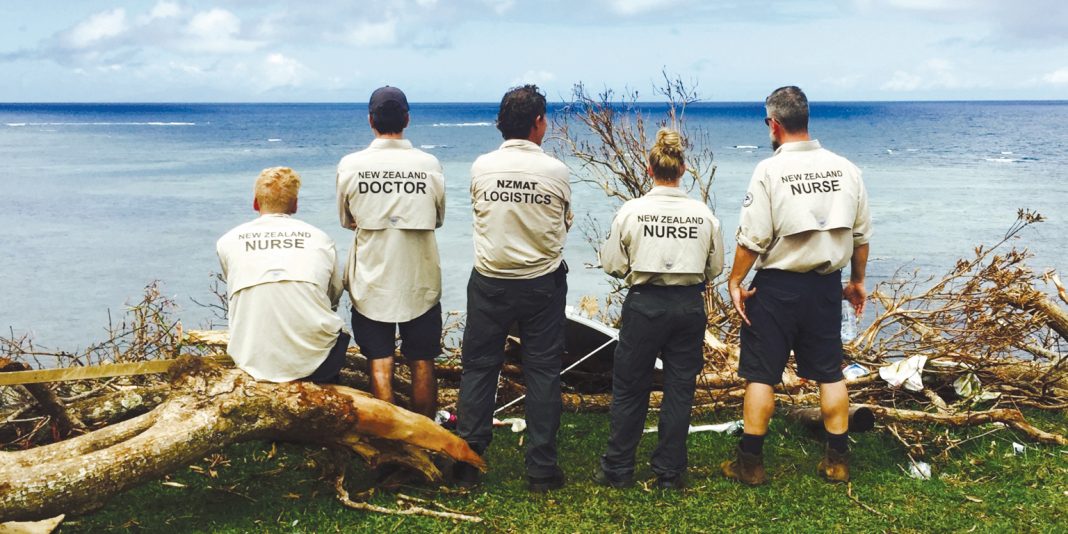Lucas Fraser says volunteering for New Zealand’s Medical Assistance Team gives you the chance to help out when disaster strikes with minimal disruption to your regular job.
The helicopter flew off and left them in what used to be a village. Where once there was crops there was now bare rock and only the foundations remained of the villagers’ homes. Stunned the team headed up the hill to another village where a health clinic was still standing – though stripped off its roof. They set up a tent and set to work helping the local health workers tend island residents still dazed after Cyclone Winston’s up to 300km winds and storm surges had devastated their island home.
In the almost five years since Fraser first joined New Zealand’s Medical Assistance Team (NZMAT), he has worked in Solomon’s capital Honiara after severe flash flooding and been helicoptered onto Fiji’s Koro island, which was battered by the worst of Cyclone Winston. He has also attended training in Darwin and Indonesia. After those short, sharp missions of one to two weeks, he returns to his ‘day job’ as a duty nurse manager at Waikato Hospital.
Fraser had recently returned from working in Saudi Arabia when he signed up in 2013 to join NZMAT’s first cohort. NZMAT is a team of volunteers recruited and trained by the Ministry of Health to be ready for rapid deployment of up to two weeks in response to government requests for health support in the event of major disasters or emergencies in our corner of the Pacific.
Flooding in the Solomons
Fraser’s first call-up came in 2014 when the first NZMAT team was deployed in response to flash flooding caused by Cyclone Ita in the Solomon Islands’ capital Honiara, which killed 22 people and washed away the homes of 12,000 of the city’s poorest residents, affecting more than 50,000 people. Displaced people living in cramped camps contributed to a dengue fever outbreak and contaminated water supplies meant gastroenteritis and infections were major issues.
An advance team was sent to assess how NZMAT could best help out and four days after the initial phone call alert Fraser and his teammates were on a commercial flight to Honiara with a few hundred kilograms of excess luggage, including requested antibiotics and other necessary supplies. The New Zealand team of doctors and nurses – in partnership with some doctors from Australia’s established MAT (known as AUSMAT) – were to be based in the emergency department of Honiara’s main hospital to help local staff with the extra influx of flood-affected people.
The exhausted local doctors and nurses were happy to see the team, after dealing with the flooding aftermath for over a week with very little respite to be able to help out their own affected loved ones. “They were working on empty,” recalls Fraser.
It was to be a fortnight of hot, humid, hard and sometimes heartbreaking work, but Fraser says it was probably still the most rewarding time of his nursing career to date. “You had to use all the skills you had to try and make the best decisions.”
Much of Fraser’s time was split between triaging the waiting crowds on the tropical hospital’s deck in 35-degree heat or working with the patients in the crowded waiting room.
Fraser says there were consistently 50–60 people waiting outside ED at any one time to be seen. Only the very, very unwell got to the front of the queue – the rest were triaged and moved into a small three-by-10-metre waiting room that was crammed with people who were waiting up to two days to see a doctor because the on-duty doctors were so busy.
Up to 15 severely ill babies and children were arriving each day, dehydrated – some to the point of unconsciousness – as a result of dengue fever or gastroenteritis, and in need of urgent resuscitation and intravenous fluids.
“There were children dying on a reasonably regular basis because of how severe the gastro outbreak was,” says Fraser. People were also coming in with infected cuts from treading on corrugated iron submerged in the dirty flood water, and the normal ED workload of people with heart attacks to sepsis.
If a patient needed admitting to the ward, they would be walked or carried to the ward where a nurse would make space – even if it meant topping and tailing two patients to a bed – and then carry on with their work. Fraser says it wasn’t uncommon in the resuscitation room to have two children being resuscitated on the same bed and the parents wouldn’t bat an eye. “It’s just what you do.”
It was challenging but also “very, very rewarding” work.
“There are very few occasions in medicine and nursing where you have to fully rely on what you know – often you can refer to someone, request a test or specialist opinion – but there you had to dig deep into your memory banks and do as good as you could.”


The aftermath of Cyclone Winston in Fiji
When Cyclone Winston hit Fiji in February 2016 – the most severe tropical cyclone ever recorded in the Southern Hemisphere – there was little doubt that NZMAT would be deployed and Fraser was ready for the call. More than 40 people had been killed in the Category Five cyclone, which cut a swathe through Fiji, destroying an estimated 32,000 houses, 88 health facilities and affecting 350,000 people in the cyclone’s path.
Several teams of NZMAT volunteers were flown to the area in an air force cargo plane and after a briefing the five members of the mobile team to which Fraser was assigned were helicoptered onto Koro Island, which had borne the brunt of the cyclone.
Koro had been hit by 200–300-kilometres-an-hour winds and tsunami-like storm surges, which had combined to destroy nearly 1,000 homes and most of the medical centres and schools, stripped the coconut palms back to sticks, and in some areas washed away not only the crops but the topsoil in which they had grown.
By the time the Kiwis arrived, nearly a week after the cyclone, most of the severely wounded had been evacuated and a number of the about 4,000 island residents had crossed to the main island to escape the devastation that had destroyed their homes and livelihoods.
The helicopter left and the team – three nurses, a doctor, a logistician (firefighter when at home) and their Fiji Health Ministry support person – looked around them at the stripped and uprooted trees, and the foundations of where a village had stood. They headed up the hill to a less-devastated village at the top and set up their tent beside the hill village’s health clinic, which was standing roofless, but Australian armed forces had managed to pull a tarp over for protection.
The Kiwis spent the first couple of days with local staff helping to treat the villagers who turned up to the clinic with cuts from cyclone debris, infections or needing medication to replace that which had been lost along with their homes. If there was any downtime they tried to help restore order in the clinic and sort through the rain-damaged and wind-tossed medications and supplies to see what could be salvaged, plus unpack and store the medications that had been air-dropped in.
Once on top of the clinic’s work, they headed out in convoy with an Australian defence force team that was clearing the roads to more isolated villages. When the convoy arrived in a village, the team’s Fijian Health Ministry support person liaised with the chief to use any building still standing to offer a four-hour clinic to the injured and ill before moving on to the next village and setting up another short-lived clinic. “The injuries we were seeing at that point were old injuries but we were still seeing significant lacerations that needed IV antibiotics and a few fractures that needed to go back to the main island to be set.”
With the cyclone still so recent, most islanders were still in shock at their losses, but on the last day of the team’s week on the island they watched about 40 villagers go down the hill to take a symbolic first step to rebuilding their destroyed coastal village by moving a log across a stream to create a footbridge.
Back to the day jobs
Once the volunteer missions are over, Fraser and the team then fly back to their day jobs and wait for the phone to ring again.
For Fraser, part of the appeal of NZMAT volunteer work is that it is a form of volunteering that fits into the real world with minimum disruption to family and work life – as long as employers and workmates are supportive.
Thankfully, New Zealand’s corner of the Pacific has not had a major disaster of the scale of 2016’s Cyclone Winston, 2015’s Cyclone Pam, or 2014’s Cyclone Ita in recent times. “But if something big happens,” says Fraser, “it [NZMAT] gives you the opportunity to help, which is often what you want when you are home looking at the pictures on the TV and thinking ‘I feel like I should be helping’ – then that’s an avenue to do it.
“And there is very little sacrifice – you are still getting paid; it’s only a few weeks and it’s exciting – you don’t get to do that every day. And for me it gives me the extra element of nursing – I think without it I wouldn’t still be nursing, but knowing I can help communities really in need when they need it the most – it keeps me in the job.”





















